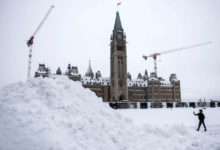With pre-election summer looming, Conservatives hang on to their lead
When this election year kicked off, Justin Trudeau’s Liberals were on track for victory in the fall federal election. Now, as parliamentarians prepare to head home after this week’s expected adjournment of the House of Commons, they’ll return to a very different political landscape.
It’s one that favours Andrew Scheer’s Conservatives — and it’s one that might be settling in as the new normal.
The CBC’s Canada Poll Tracker, an aggregation of all publicly available polling data, had a lot of numbers to crunch lately, with six polls being published over the past week.
The averages now show the Conservatives leading with 36 per cent support among decided voters nationwide, putting them a little more than six percentage points ahead of the Liberals, who trail with 29.8 per cent.
Jagmeet Singh’s New Democrats are in third with 15.1 per cent, followed closely by Elizabeth May’s Greens at 10.7 per cent.
Another 4.3 per cent say they will vote for the Bloc Québécois, with 2.5 per cent supporting Maxime Bernier’s People’s Party and 1.5 per cent saying they will support other parties or independent candidates.
These numbers have the Conservatives straddling the 170 seats needed to form a majority government, according to the Poll Tracker’s seat projections. Accordingly, if the election were held today there would be a 74 per cent chance that the Conservatives would emerge with the most seats. A majority is nearly a toss-up.
This is not how the year began. Just after New Year’s, the Poll Tracker awarded the Liberals a three-point lead nationwide and gave them a 72 per cent chance of winning the most seats. The fallout from the SNC-Lavalin affair robbed the Liberals of their advantage, pushing them down behind the Conservatives, who experienced a modest increase in support.
There are some signs that the Liberals have halted their slide — the party has been hovering around 30 per cent since the beginning of May after losing roughly seven points in the preceding months.
But they aren’t the only party in stasis. The Conservative average has held firm within a tight band of 34.5 to 36.9 per cent support since Feb. 20, nearly four months ago. The New Democrats have been stuck between 15 and 17 per cent since the beginning of March.
The dial just isn’t moving. The summer’s political lull might not be what gets it to budge.
Greens hitting new highs
There is one party to keep an eye on, however.
After a series of provincial breakthroughs and a federal byelection victory in the B.C. riding of Nanaimo–Ladysmith last month, the Greens have a bit of momentum going into the summer.
Nationally, the Greens have gained between four and five points since the beginning of the year — a significant increase, considering the party was only at 6.3 per cent in the Poll Tracker on Jan. 2.
Their largest gains have come in regions where they already hold seats at the provincial level. Since the beginning of the year, the Greens are up five points in both Ontario and Atlantic Canada (where they are now ahead of the NDP) and nearly eight points in British Columbia.
The party has had more modest gains of two points in Alberta and three points in both the Prairies and Quebec.
The result is that the Greens have hit all-time polling highs in a few regions of the country and are now projected to win between three and 12 seats, up substantially from the range of one to three seats they were looking at when the year began.
Conservatives lead in most parts of the country
At the top of the tables, however, the Conservatives are leading everywhere except Quebec and Atlantic Canada. The polls put the party ahead of the Liberals by about six points in B.C., 28 points in the Prairies and 42 points in Alberta.
There is some discrepancy in the polls in Ontario, with half of the six surveys giving the Conservatives a lead of just two or three points over the Liberals. Two others put the gap at six and 10 points, while a third has the Liberals ahead by seven. The Poll Tracker splits the difference and gives the Conservatives the edge by about four points — roughly where things have been for most of the last few months.
Atlantic Canada also shows some big variations, stretching from a lead of 25 points for the Liberals to a 16-point edge for the Conservatives. But sample sizes in the region are usually small, so wide variations aren’t unusual. The Poll Tracker smoothes it out to a three-point Liberal lead — which, again, is where things have been holding for some time.
But the most significant disagreement in the polls this week has been in Quebec. And its implications could be enormous.
The Quebec question
With 32 per cent against 24 per cent for the Conservatives, the Liberals still hold a comfortable lead in Quebec according to the Poll Tracker. But the individual surveys published this week paint very different portraits of what’s going on in the province.
Four of the six polls published in the last week gave the Liberals a wide lead in Quebec, ranging from 12 to 19 points. That’s in line with what most other polls have been showing ever since the SNC-Lavalin affair sent the party’s lead plunging below the 20+ points it was enjoying earlier in the year.
But two other surveys — by the Angus Reid Institute and Léger/Canadian Press — broke with convention and gave the Conservatives a narrow two-point lead in the province.
If the Liberals are ahead by a dozen points or more, then they are in a very good position to win some 50 seats in Quebec. That’s a gain of 10 from their performance in the 2015 federal election. But if the Conservatives are ahead by two, then the Liberals drop to somewhere around 30 seats in the province, while the Conservatives would probably win about 22 seats. That alone would be enough to push the Conservatives into majority government territory.
The findings of the two polls vary in their significance. The Angus Reid Institute has given the Liberals an average lead of just a single point in its previous polls conducted in Quebec this year. That suggests their latest result is not picking up any significant shift in support, and methodology could explain why ARI is showing a close race in Quebec when other pollsters aren’t.
However, Léger has given the Liberals an average lead of 11 points in its previous surveys in Quebec, so the two-point Conservative edge in this latest poll is noteworthy. Determining whether it’s an outlier or the beginning of a new trend will have to await corroboration from other polls in the coming weeks. A breakthrough like this would be the last piece of the puzzle for Scheer’s Conservatives in their quest for a majority government.
But the trend lines have been reliably flat for months. The safe money is on the new normal staying that way — at least for a little while longer.








Redes Sociais - Comentários